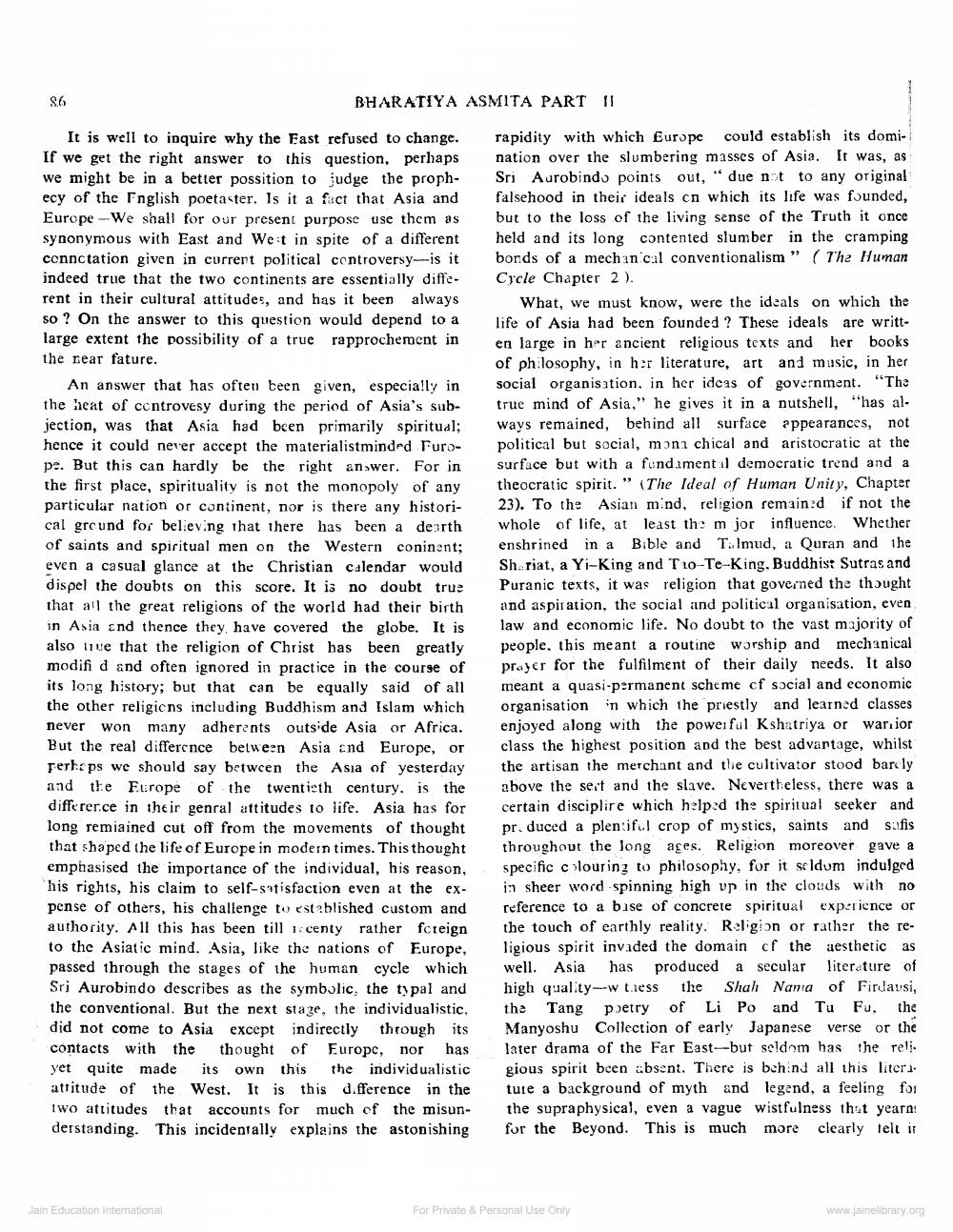________________
86
BHARATIYA ASMITA PART 1
It is well to inquire why the East refused to change. If we get the right answer to this question, perhaps we might be in a better possition to judge the prophecy of the English poetaster. Is it a fact that Asia and Europe - We shall for our present purpose use them as synonymous with East and Wet in spite of a different ccnnctation given in current political controversy-is it indeed true that the two continents are essentially different in their cultural attitudes, and has it been always so ? On the answer to this question would depend to a large extent the possibility of a true rapprochement in the rear fature.
An answer that has often teen given, especially in the heat of controvesy during the period of Asia's subjection, was that Asia had been primarily spiritual; hence it could never accept the materialistminded Furope. But this can hardly be the right answer. For in the first place, spirituality is not the monopoly of any particular nation or continent, nor is there any historical ground for believing that there has been a dearth of saints and spiritual men on the Western coninent; even a casual glance at the Christian calendar would dispel the doubts on this score. It is no doubt true that all the great religions of the world had their birth in Asia and thence they have covered the globe. It is also true that the religion of Christ has been greatly modifi d and often ignored in practice in the course of its long history; but that can be equally said of all the other religions including Buddhism and Islam which never won many adherents outside Asia or Africa. But the real difference between Asia and Europe, or Ferhaps we should say betwcen the Asia of yesterday and the Europe of the twentieth century, is the diffe rer.ce in their genral attitudes to life. Asia has for long remiained cut off from the movements of thought that shaped the life of Europe in modern times. This thought emphasised the importance of the individual, his reason, his rights, his claim to self-satisfaction even at the expense of others, his challenge to established custom and authority. All this has been till 1 centy rather foreign to the Asiatic mind. Asia, like the nations of Europe, passed through the stages of the human cycle which Sri Aurobindo describes as the symbolic, the typal and the conventional. But the next stage, the individualistic. did not come to Asia except indirectly through its contacts with the thought of Europe, nor has yet quite made its own this the individualistic attitude of the West. It is this difference in the two attitudes that accounts for much of the misunderstanding. This incidentally explains the astonishing
rapidity with which Europe could establish its domination over the slumbering masses of Asia. It was, as Sri Aurobindo points out, "due not to any original falsehood in their ideals on which its life was founded, but to the loss of the living sense of the Truth it once held and its long contented slumber in the cramping bonds of a mechan.cal conventionalism" (The Human Cycle Chapter 2).
What, we must know, were the ideals on which the life of Asia had been founded? These ideals are written large in her ancient religious texts and her books of philosophy, in her literature, art and music, in her social organisation, in her ideas of government. "The true mind of Asia," he gives it in a nutshell, "has always remained, behind all surface appearances, not political but social, moni chical and aristocratic at the surface but with a fondimental democratic trend and a theocratic spirit." (The Ideal of Human Unity, Chapter 23). To the Asian mind, religion remain:d if not the whole of life, at least th: m jor influence. Whether enshrined in a Bible and T. Imud, a Quran and the Shariat, a Yi-King and Tło-Te-King. Buddhist Sutras and Puranic texts, it was religion that governed the thought and aspiration, the social and political organisation, even law and economic life. No doubt to the vast majority of people, this meant a routine worship and mechanical prayer for the fulfilment of their daily needs. It also meant a quasi-permanent scheme of social and economic organisation in which the priestly and learned classes enjoyed along with the powerful Kshatriya or war ior class the highest position and the best advantage, whilst the artisan the merchant and the cultivator stood barely above the sect and the slave. Nevertheless, there was a certain disciplire which helped the spiritual seeker and pr. duced a plentiful crop of my stics, saints and sufis throughout the long ages. Religion moreover gave a specific colouring to philosophy, for it scIdum indulged in sheer word spinning high up in the clouds with no reference to a base of concrete spiritual experience or the touch of earthly reality. Religion or rather the religious spirit invaded the domain cf the aesthetic as well. Asia has produced a secular literature of high quality--w tress the Shah Nania of Firdausi, the Tang poetry of Li Po and Tu Fu, the Manyoshu Collection of early Japanese verse or the later drama of the Far East-but seldom has the reli, gious spirit been absent. There is behind all this liter). tuie a background of myth and legend, a feeling for the supraphysical, even a vague wistfulness that yearn for the Beyond. This is much more clearly telt in
Jain Education Intemational
For Private & Personal Use Only
www.jainelibrary.org




